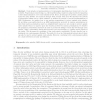Free Online Productivity Tools
i2Speak
i2Symbol
i2OCR
iTex2Img
iWeb2Print
iWeb2Shot
i2Type
iPdf2Split
iPdf2Merge
i2Bopomofo
i2Arabic
i2Style
i2Image
i2PDF
iLatex2Rtf
Sci2ools
114
Voted
SACRYPT
2007
Springer
2007
Springer
Analysis of Countermeasures Against Access Driven Cache Attacks on AES
Cache attacks on implementations of cryptographic algorithms have turned out to be very powerful. Progress in processor design, e.g., like hyperthreading, requires to adapt models for tampering or side-channel attacks to cover cache attacks as well. Hence, in this paper we present a rather general model for cache attacks. Our model is stronger than recently used ones. We introduce the notions of information leakage and so called resistance to analyze the security of several implementations of AES. Furthermore, we analyze how to use random permutations to protect against cache attacks. By providing a successful attack on an AES implementation protected by random permutations we show that random permutations used in a straightforward manner are not enough to protect against cache attacks. Hence, to improve upon the security provided by random permutations, we describe the property a permutation must have in order to prevent the leakage of some key bits through cache attacks. Using a perm...
| Added | 09 Jun 2010 |
| Updated | 09 Jun 2010 |
| Type | Conference |
| Year | 2007 |
| Where | SACRYPT |
| Authors | Johannes Blömer, Volker Krummel |
Comments (0)

